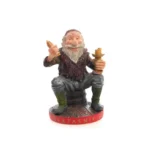Flotnari - Fat Sock Stuffer

“Flotnari moves quietly, with grease-stained fingers, leaving behind ruined clothing and the smell of fat in the cold night air.”
Introduction
Flotnari, often known as the “Fat Sock Stuffer,” is one of the more peculiar and unsettling Yule Lads. Unlike her louder, more mischievous brothers, her method of causing havoc is quieter—but no less frustrating. She sneaks into homes under the cover of night and, instead of stealing food or causing loud commotion, she targets winter garments. Her peculiar habit? Stuffing socks, gloves, and other clothing with fat and grease, rendering them greasy, unwearable, and practically ruined. In the brutal cold of Icelandic winters, this could be more than just an inconvenience—it was a real danger.
Historical Background and Earliest Known Reference
The earliest references to Flotnari come from oral Icelandic traditions passed down through generations. Stories of her antics would have been shared in households, particularly during the darkest days of winter when keeping clothing dry and intact was crucial for survival. Butter and fat were precious resources, used for both cooking and providing necessary energy to survive the season. But in Flotnari’s hands, these valuable items became tools for sabotage. By stuffing them into clothes, she not only ruined the garments but wasted vital supplies. This quiet destruction, while not as flashy as her brothers’ tricks, was just as feared by families trying to scrape by in harsh conditions.
Physical Appearance and Clothing
Flotnari is often depicted as a tall, gaunt woman with a peculiar sheen to her clothing—permanently stained from her obsession with grease and fat. Her hands, long and bony, are always slick with butter, making her every touch unwelcome. She wears traditional Icelandic garments, but they hang loose and tattered on her frame, soaked with the fat she stuffs into others’ clothing. Her eyes glint with a mischievous hunger, but her appearance is less menacing and more quietly unsettling—her destruction is a slow burn rather than an outright attack.
Likes, Dislikes, and Habits
Flotnari’s favorite targets are freshly laundered socks, gloves, and other winter garments left out to dry. She delights in ruining them by smearing fat and grease into the fabric, leaving them sticky and unusable. Her greatest dislike? Houses where clothing is carefully watched over or well-guarded, where she finds no opportunity to carry out her sneaky sabotage. Her habits are consistent—waiting for nightfall, sneaking into homes, and stuffing garments with butter and grease before disappearing, leaving nothing but a ruined mess for her victims to discover.
Types of Pranks and Mischief
Flotnari’s pranks are subtler than those of her brothers, but their impact can be far greater. While her brothers might slam doors or steal food, Flotnari’s mischief lingers, leaving families scrambling to repair or replace essential winter clothing. She slips into homes quietly and without warning, seeking out the garments most needed during the winter months and stuffing them full of fat. Families would wake to find their clothes greasy, stained, and no longer useful—an eerie reminder of her presence during the dark nights.
Relationship with Humans and Other Yule Lads
Flotnari’s relationship with humans is largely antagonistic, as her actions directly impact their ability to survive the winter. Ruining clothing meant exposure to the elements, and in ancient Icelandic society, that was no small thing. However, she does not attack outright or cause harm like some of her more aggressive brothers, making her a more frustrating nuisance than a true threat. Among her brothers, Flotnari tends to align with food-obsessed Yule Lads, particularly those who target resources in less obvious ways, like Þvörusleikir (Spoon Licker) or Ketkrókur (Meat Hook). They share a quieter method of mischief, preferring to steal or spoil rather than wreak immediate havoc.
Modern Depictions and Popularity
Flotnari may not be as well-known or beloved as some of her more famous brothers, but in recent years, there has been a growing interest in reviving the stories of the forgotten Yule Lads. In modern children’s books and holiday decorations, she is often depicted with a bit of humor—her grease-covered hands and mischievous smile making her a more light-hearted figure than her folklore origins suggest. While still a figure of quiet dread, there is a growing appreciation for her place among the darker Yule Lads.
Fun Facts and Trivia
- Flotnari’s name directly translates to “Fat Spreader,” but she is more commonly referred to as “Fat Sock Stuffer” due to her tendency to target winter garments.
- The wastefulness of Flotnari’s actions mirrors the fear of wasted resources during Iceland’s harsh winters, where butter and fat were essential for survival.
- Unlike many of her brothers who cause noisy or visible chaos, Flotnari’s pranks often go unnoticed until it’s too late, making her an unsettling figure in Icelandic folklore.
Astrological Sign: Virgo
Flotnari’s careful, precise methods align her with the traits of Virgo. Virgos are known for their attention to detail, and Flotnari’s subtle approach to ruining clothes reflects that same meticulousness. She waits for the perfect moment, avoiding direct confrontation, and carefully stuffs garments with fat when no one is looking, ensuring maximum frustration with minimal noise.
Cultural Significance
Flotnari represents the dangers of wastefulness and the importance of caring for one’s resources. In a time when winter supplies were scarce, her sneaky habits served as a reminder that even small amounts of waste could have severe consequences.
Voices of Tradition
“Flotnari færðist hljóðlega um húsið, fingur hennar sleipir af fitu, skiljandi eftir sig sokka og hanska ónýta.“




